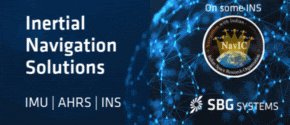Articles in the Navigation Category

Matthew Anseau
As the consumer satellite navigation industry continues to evolve, it is interesting to look at the various business models of the industry players and how these drive their market positioning. At a basic level, we see two types of business models currently in the industry. On one side, there are the map providers; a mixture of global and regional/local players and on the other, data-driven technology firms such as Google (Google Maps) and Microsoft (Bing Maps). Whilst the former have expertise in map development and navigation, the latter tend to be stronger in content acquisition and management.

Whenever there is a need for continuous navigation, radio-technical systems are usually integrated with inertial navigation systems (INS) or dead-reckoning systems (DR). Due to large dimensions and power consumption, as well as high prices, INS systems have been traditionally applied in high-end or military applications. Recently an unprecedented decrease of all the above mentioned factors have been witnessed, making inertial navigation suitable for a wider set of applications. However, the dead-reckoning method is still the preferred choice in low-cost land navigation systems.

A brief outline of the three segments – User Segment, Space Segment and Ground Segment necessary for
implementation of an SBAS system over the Indian airspace. International Civil Aviation Organisation (ICAO) Member States have endorsed Global Satellite Navigation System (GNSS) as a primary future system for aviation. GNSS provides world-wide coverage for seamless aircraft navigation. Satellite transmission along with ground enhancement will enable the users to perform on-board position determination for enroute, terminal, non-precision and precision approaches.

Jong-Hwa Song,GYU-IN JEE
This paper describes the performance improvement of GPS/DR (Global Positioning System/Dead Reckoning) Integration system utilizing the area decision algorithm and vehicle movement information. In GPS/DR Integration system, generally DR sensor errors are estimated and corrected using GPS information when GPS is available. In GPS signal blockage area, i.e., tunnel and underground parking area, DR sensor errors are accumulated and navigation solution is diverged eventually. We utilize the car movement…

Global Positioning System (GPS) provides precise timing, position, and velocity information by utilizing the constellation of satellites and a remote receiver that uses range measurements to the satellites and spatial trilateration techniques. In addition, more navigation satellite systems including Russia’s GLONASS, Europe’s Galileo, and PRC’s Compass will be available for the coming years. Those systems will form the mainframe of future Global Navigation Satellite System…

Sherman Lo, Benjamin Peterson, Per Enge
This article assesses the security of eLoran and discusses how its features can be utilized to provide defenses against likely attacks
Global Navigation Satellite Systems (GNSS) have become increasingly interwoven into the fabric of our infrastructure and economic system. However, as the services provided by GNSS become more important for safety …

The reference scenario is defined by a set of navigation systems; each system is composed by a set of signal generators (constellation) and by a common time reference. Each transmitter must be synchronized to the time base; this operation is performed using different algorithms in order to generate a time correction to be transmitted to the receiver…

Accurate and continuous position computation is a key task for vehicle navigation and telematics applications. In most portable car navigation and telematics devices, the position is determined based only on GPS data. However, in urban canyons stand-alone GPS suffers signal masking and reflections of the signal from buildings, large vehicles, and other reflective surfaces. Driving tests in such metropolises as Hong Kong…












 (5.00 out of 5)
(5.00 out of 5)